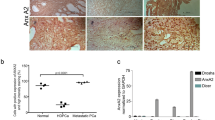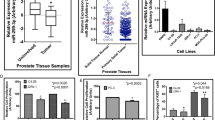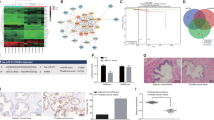Abstract
Androgen signaling, via the androgen receptor (AR), is crucial in mediating prostate cancer (PCa) initiation and progression. Identifying new downstream effectors of the androgens/AR pathway will allow a better understanding of these mechanisms and could reveal novel biomarkers and/or therapeutic agents to improve the rate of patient survival. We compared the microRNA expression profiles in androgen-sensitive LNCaP cells stimulated or not with 1 nM R1881 by performing a high-throughput reverse transcriptase–quantitative PCR and found that miR-135a was upregulated. After androgen stimulation, we showed that AR directly activates the transcription of miR-135a2 gene by binding to an androgen response element in the promoter region. Our findings identify miR-135a as a novel effector in androgens/AR signaling. Using xenograft experiments in chick embryos and adult male mice, we showed that miR-135a overexpression decreases in vivo invasion abilities of prostate PC-3 cells. Through in vitro wound-healing migration and invasion assays, we demonstrated that this effect is mediated through downregulating ROCK1 and ROCK2 expression, two genes that we characterized as miR-135a direct target genes. In human surgical samples from prostatectomy, we observed that miR-135a expression was lower in tumoral compared with paired adjacent normal tissues, mainly in tumors classified with a high Gleason score (⩾8). Moreover, miR-135a expression is lower in invasive tumors, showing extraprostatic extension, as compared with intraprostatic localized tumors. In tumor relative to normal glands, we also showed a more frequently higher ROCK1 protein expression determined using a semi-quantitative immunohistochemistry analysis. Therefore, in tumor cells, the lower miR-135a expression could lead to a higher ROCK1 protein expression, which could explain their invasion abilities. The highlighted relationship between miR-135a expression level and the degree of disease aggressiveness suggests that miR-135a may be considered as a prognostic marker in human PCa.
This is a preview of subscription content, access via your institution
Access options
Subscribe to this journal
Receive 50 print issues and online access
$259.00 per year
only $5.18 per issue
Buy this article
- Purchase on Springer Link
- Instant access to full article PDF
Prices may be subject to local taxes which are calculated during checkout






Similar content being viewed by others

References
Cunha GR, Ricke W, Thomson A, Marker PC, Risbridger G, Hayward SW et al. Hormonal, cellular, and molecular regulation of normal and neoplastic prostatic development. J Steroid Biochem Mol Biol 2004; 92: 221–236.
Matsumoto T, Sakari M, Okada M, Yokoyama A, Takahashi S, Kouzmenko A et al. The androgen receptor in health and disease. Annu Rev Physiol 2013; 75: 201–224.
Green SM, Mostaghel EA, Nelson PS . Androgen action and metabolism in prostate cancer. Mol Cell Endocrinol 2012; 360: 3–13.
Denayer S, Helsen C, Thorrez L, Haelens A, Claessens F . The rules of DNA recognition by the androgen receptor. Mol Endocrinol 2010; 24: 898–913.
Chen Y, Clegg NJ, Scher HI . Anti-androgens and androgen-depleting therapies in prostate cancer: new agents for an established target. Lancet Oncol 2009; 10: 981–991.
Feldman BJ, Feldman D . The development of androgen-independent prostate cancer. Nat Rev Cancer 2001; 1: 34–45.
Knudsen KE, Penning TM . Partners in crime: deregulation of AR activity and androgen synthesis in prostate cancer. Trends Endocrinol Metab 2010; 21: 315–324.
Takayama KI, Inoue S . Transcriptional network of androgen receptor in prostate cancer progression. Int J Urol 2013; 20: 756–768.
Bartel DP . MicroRNAs: target recognition and regulatory functions. Cell 2009; 136: 215–233.
Esquela-Kerscher A, Slack FJ . Oncomirs—microRNAs with a role in cancer. Nat Rev Cancer 2006; 6: 259–269.
Xi JJ . MicroRNAs in cancer. Cancer Treat Res 2013; 158: 119–137.
Jansson MD, Lund AH . MicroRNA and cancer. Mol Oncol 2012; 6: 590–610.
Hurst DR, Edmonds MD, Welch DR . Metastamir: the field of metastasis-regulatory microRNA is spreading. Cancer Res 2009; 69: 7495–7498.
Bouyssou JM, Manier S, Huynh D, Issa S, Roccaro AM, Ghobrial IM . Regulation of microRNAs in cancer metastasis. Biochim Biophys Acta 2014; 1845: 255–265.
Croce CM . Causes and consequences of microRNA dysregulation in cancer. Nat Rev Genetics 2009; 10: 704–714.
Fang YX, Gao WQ . Roles of microRNAs during prostatic tumorigenesis and tumor progression. Oncogene 2014; 33: 135–147.
Watahiki A, Wang Y, Morris J, Dennis K, O'Dwyer HM, Gleave M et al. MicroRNAs associated with metastatic prostate cancer. PLoS One 2011; 6: e24950.
Hassan O, Ahmad A, Sethi S, Sarkar FH . Recent updates on the role of microRNAs in prostate cancer. J Hematol Oncol 2012; 5: 9.
Fendler A, Stephan C, Yousef GM, Jung K . MicroRNAs as regulators of signal transduction in urological tumors. Clin Chem 57: 954–968.
Ribas J, Ni X, Haffner M, Wentzel EA, Salmasi AH, Chowdhury WH et al. miR-21: an androgen receptor-regulated microRNA that promotes hormone-dependent and hormone-independent prostate cancer growth. Cancer Res 2009; 69: 7165–7169.
Jalava SE, Urbanucci A, Latonen L, Waltering KK, Sahu B, Janne OA et al. Androgen-regulated miR-32 targets BTG2 and is overexpressed in castration-resistant prostate cancer. Oncogene 2012; 31: 4460–4471.
Fletcher CE, Dart DA, Sita-Lumsden A, Cheng H, Rennie PS, Bevan CL . Androgen-regulated processing of the oncomir miR-27a, which targets Prohibitin in prostate cancer. Hum Mol Genet 2012; 21: 3112–3127.
Sun D, Layer R, Mueller AC, Cichewicz MA, Negishi M, Paschal BM et al. Regulation of several androgen-induced genes through the repression of the miR-99a/let-7c/miR-125b-2 miRNA cluster in prostate cancer cells. Oncogene 2014; 33: 1448–1457.
Waltering KK, Porkka KP, Jalava SE, Urbanucci A, Kohonen PJ, Latonen LM et al. Androgen regulation of micro-RNAs in prostate cancer. Prostate 2011; 71: 604–614.
Ambs S, Prueitt RL, Yi M, Hudson RS, Howe TM, Petrocca F et al. Genomic profiling of microRNA and messenger RNA reveals deregulated microRNA expression in prostate cancer. Cancer Res 2008; 68: 6162–6170.
Murata T, Takayama K, Katayama S, Urano T, Horie-Inoue K, Ikeda K et al. miR-148a is an androgen-responsive microRNA that promotes LNCaP prostate cell growth by repressing its target CAND1 expression. Prostate Cancer Prostatic Dis 2010; 13: 356–361.
Amano M, Nakayama M, Kaibuchi K . Rho-kinase/ROCK: a key regulator of the cytoskeleton and cell polarity. Cytoskeleton (Hoboken) 2010; 67: 545–554.
Riento K, Ridley AJ . Rocks: multifunctional kinases in cell behaviour. Nat Rev Mol Cell Biol 2003; 4: 446–456.
Somlyo AV, Bradshaw D, Ramos S, Murphy C, Myers CE, Somlyo AP . Rho-kinase inhibitor retards migration and in vivo dissemination of human prostate cancer cells. Biochem Biophys Res Commun 2000; 269: 652–659.
Golubovskaya VM, Sumbler B, Ho B, Yemma M, Cance WG . MiR-138 and MiR-135 directly target focal adhesion kinase, inhibit cell invasion, and increase sensitivity to chemotherapy in cancer cells. Anticancer Agents Med Chem 2014; 14: 18–28.
Shin JY, Kim YI, Cho SJ, Lee MK, Kook MC, Lee JH et al. MicroRNA 135a suppresses lymph node metastasis through down-regulation of ROCK1 in early gastric cancer. PLoS One 2014; 9: e85205.
Chen Y, Zhang J, Wang H, Zhao J, Xu C, Du Y et al. miRNA-135a promotes breast cancer cell migration and invasion by targeting HOXA10. BMC Cancer 2012; 12: 111.
Zhou W, Li X, Liu F, Xiao Z, He M, Shen S et al. MiR-135a promotes growth and invasion of colorectal cancer via metastasis suppressor 1 in vitro. Acta Biochim Biophys Sin (Shanghai) 2012; 44: 838–846.
Leung CO, Deng W, Ye TM, Ngan HY, Tsao GS, Cheung AN et al. Mir-135a leads to cervical cancer cell transformation through regulation of ss-catenin via a siah1-dependent ubiquitin proteosomal pathway. Carcinogenesis (e-pub ahead of print 25 February 2014).
Ma S, Chan YP, Kwan PS, Lee TK, Yan M, Tang KH et al. MicroRNA-616 induces androgen-independent growth of prostate cancer cells by suppressing expression of tissue factor pathway inhibitor TFPI-2. Cancer Res 2011; 71: 583–592.
Wang G, Wang Y, Feng W, Wang X, Yang JY, Zhao Y et al. Transcription factor and microRNA regulation in androgen-dependent and -independent prostate cancer cells. BMC Genomics 2008; 9 (Suppl 2): S22.
DeVere White RW, Vinall RL, Tepper CG, Shi XB . MicroRNAs and their potential for translation in prostate cancer. Urol Oncol 2009; 27: 307–311.
Zheng C, Yinghao S, Li J . MiR-221 expression affects invasion potential of human prostate carcinoma cell lines by targeting DVL2. Med Oncol 2012; 29: 815–822.
Sun D, Lee YS, Malhotra A, Kim HK, Matecic M, Evans C et al. miR-99 family of MicroRNAs suppresses the expression of prostate-specific antigen and prostate cancer cell proliferation. Cancer Res 2011; 71: 1313–1324.
Li Y, Kong D, Ahmad A, Bao B, Dyson G, Sarkar FH . Epigenetic deregulation of miR-29a and miR-1256 by isoflavone contributes to the inhibition of prostate cancer cell growth and invasion. Epigenetics 2012; 7: 940–949.
Nadiminty N, Tummala R, Lou W, Zhu Y, Shi XB, Zou JX et al. MicroRNA let-7c is downregulated in prostate cancer and suppresses prostate cancer growth. PLoS One 2012; 7: e32832.
Takayama K, Tsutsumi S, Katayama S, Okayama T, Horie-Inoue K, Ikeda K et al. Integration of cap analysis of gene expression and chromatin immunoprecipitation analysis on array reveals genome-wide androgen receptor signaling in prostate cancer cells. Oncogene 2011; 30: 619–630.
Cao P, Deng Z, Wan M, Huang W, Cramer SD, Xu J et al. MicroRNA-101 negatively regulates Ezh2 and its expression is modulated by androgen receptor and HIF-1alpha/HIF-1beta. Mol Cancer 2010; 9: 108.
Wen S, Shang Z, Zhu S, Chang C, Niu Y . Androgen receptor enhances entosis, a non-apoptotic cell death, through modulation of Rho/ROCK pathway in prostate cancer cells. Prostate 2013; 73: 1306–1315.
Gonzalez-Montelongo MC, Marin R, Gomez T, Marrero-Alonso J, Diaz M . Androgens induce nongenomic stimulation of colonic contractile activity through induction of calcium sensitization and phosphorylation of LC20 and CPI-17. Mol Endocrinol 2010; 24: 1007–1023.
Wang BD, Yang Q, Ceniccola K, Bianco F, Andrawis R, Jarrett T et al. Androgen receptor-target genes in African American prostate cancer disparities. Prostate Cancer 2013; 2013: 763569.
Rao S, Lyons LS, Fahrenholtz CD, Wu F, Farooq A, Balkan W et al. A novel nuclear role for the Vav3 nucleotide exchange factor in androgen receptor coactivation in prostate cancer. Oncogene 2012; 31: 716–727.
Allioli N, Vincent S, Vlaeminck-Guillem V, Decaussin-Petrucci M, Ragage F, Ruffion A et al. TM4SF1, a novel primary androgen receptor target gene over-expressed in human prostate cancer and involved in cell migration. Prostate 2011; 71: 1239–1250.
Acknowledgements
This work was supported by grants from the Institut Mérieux and the Ligue Contre le Cancer. We thank Julien Dugas (CarMen Lab) for his contribution in statistical analyses, Céline Michaux, Karine Castellano and Béatrice Bancel (Service d’Anatomie et Cytologie Pathologiques, Hospices Civils de Lyon) for providing patient samples and performing IHC staining, Jean Viallet for performing in ovo assay, Christophe Chamot and Claire Lionnet (Microscopy core facility) and Patrick Manas (AniRA-PBES platform) of UMS3444/US8 SFR Biosciences Gerland-Lyon Sud, for assistance in wound-healing assay and performing xenograft assay in mice, respectively.
Author information
Authors and Affiliations
Corresponding authors
Ethics declarations
Competing interests
The authors declare no conflict of interest.
Additional information
Supplementary Information accompanies this paper on the Oncogene website
Supplementary information
Rights and permissions
About this article
Cite this article
Kroiss, A., Vincent, S., Decaussin-Petrucci, M. et al. Androgen-regulated microRNA-135a decreases prostate cancer cell migration and invasion through downregulating ROCK1 and ROCK2. Oncogene 34, 2846–2855 (2015). https://doi.org/10.1038/onc.2014.222
Received:
Revised:
Accepted:
Published:
Issue Date:
DOI: https://doi.org/10.1038/onc.2014.222
This article is cited by
-
Tumor-suppressing effects of miR-381-3p in pediatric acute myeloid leukemia via ROCK1 downregulation
Functional & Integrative Genomics (2023)
-
Rho Kinases in Embryonic Development and Stem Cell Research
Archivum Immunologiae et Therapiae Experimentalis (2022)
-
LINC00491 promotes cell growth and metastasis through miR-324-5p/ROCK1 in liver cancer
Journal of Translational Medicine (2021)
-
miR-135a-5p mediates memory and synaptic impairments via the Rock2/Adducin1 signaling pathway in a mouse model of Alzheimer’s disease
Nature Communications (2021)
-
Wnt/β-catenin signal transduction pathway in prostate cancer and associated drug resistance
Discover Oncology (2021)


